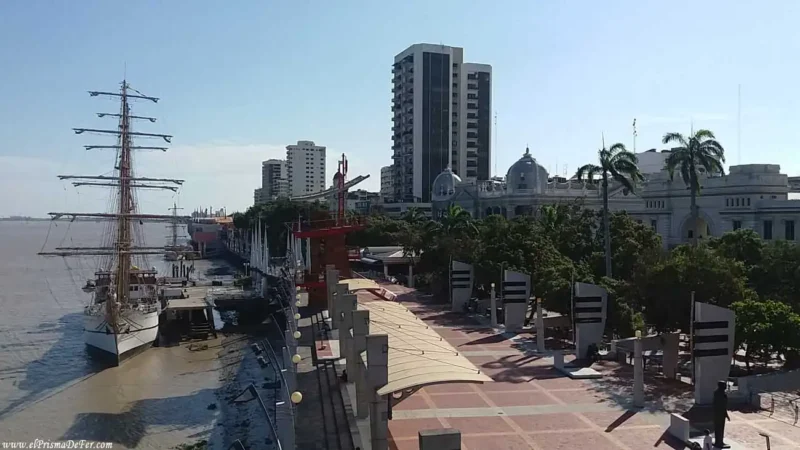Baños de Agua Santa is a place that has it all: impressive waterfalls, towering volcanoes, hot springs, adventure sports, and a very special energy that you feel as soon as you arrive.
Located at the foot of the Tungurahua volcano, this small town is known as the “Gateway to the Amazon” and has deservedly earned the title of adventure tourism capital of Ecuador.
In this post, I'll tell you what to see and do in Baños, from must-see natural attractions like the Devil's Pailón and the famous Waterfall Route, to more adrenaline-fueled experiences like zip-lining, bungee jumping, and rafting.
Plus, you'll find some practical tips to make the most of your visit and understand why this corner of the country is one of the most complete and beloved destinations.
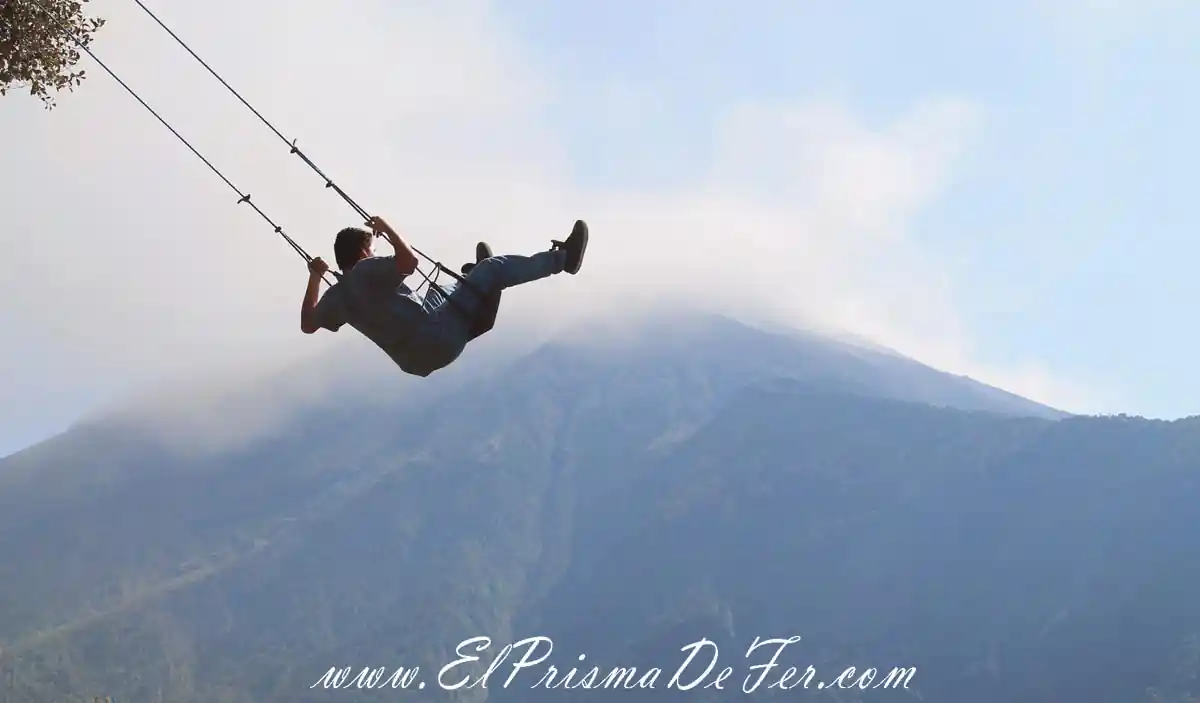

Table of Contents
Where is Baños de Agua Santa located?
Baños de Agua Santa is located in central Ecuador, within the province of Tungurahua, about 180 kilometers south of Quito and approximately 40 kilometers from Ambato.
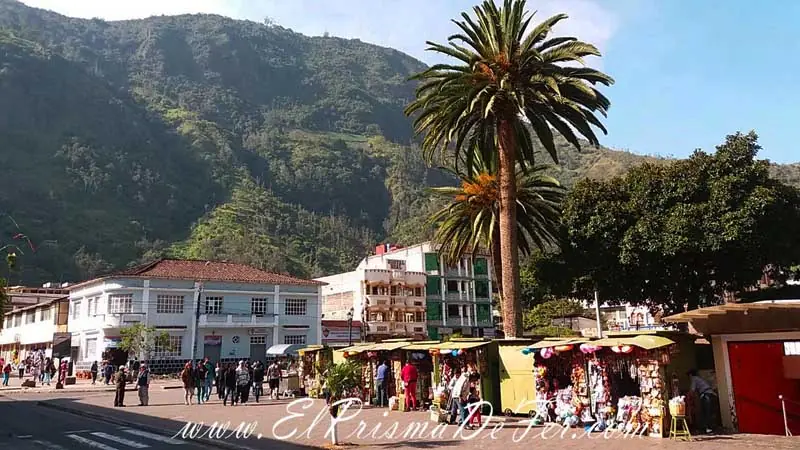
It is strategically located between the Andes mountain range and the Amazon rainforest, giving it a unique natural setting with mountains, rivers, and lush vegetation that changes as you move east.
Thanks to its location, Baños is an ideal stopover for those traveling from the Sierra to the Amazon.
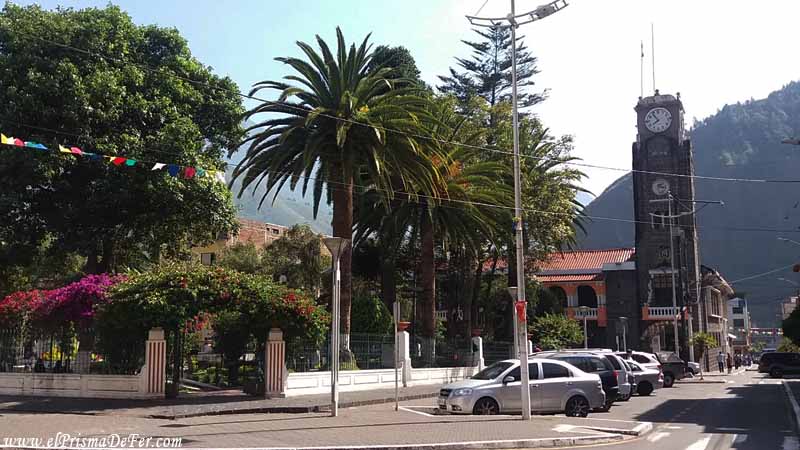
Additionally, it is easily accessible by road from several cities in the country, making it a popular destination for both locals and foreign travelers.

If you're interested in reading more about Ecuador, this trip was part of my 2-week travel itinerary around the country.
How to get to Baños
The way to get to Baños will depend on where you are coming from:
From Cuenca
Passing through Ambato (the option I took)
- From Cuenca to Ambato, buses can be taken every 15 minutes from the bus terminal.
- They reach the City of Ambato in approximately 7 or 8 hours.
- Once in Ambato, you'll need to take another bus to Baños. They also usually run every 15 minutes.
Passing through Riobamba
- Departing from Cuenca to Riobamba and then taking another bus to Baños.
From Quito
There are buses that leave from the Quitumbe Terminal to Baños bound for Baños, and others that go to Puyo or Macas, but have a stop in that city.
From Guayaquil
- Departing from Guayaquil to Baños, there are buses that go directly to Baños, leaving from the Guayaquil bus terminal.
- You can also go from Guayaquil to Ambato and from Ambato to Baños, as I mentioned before.
Map with the main places to visit in Baños
Best things to do in Baños de Agua Santa
There are many things to do in Baños, such as practicing extreme sports activities, admiring the panoramic views from different viewpoints, visiting the dozens of waterfalls in the surrounding area along the Waterfall Route, and even relaxing in the hot springs in the city.
Below I will develop the most important ones:
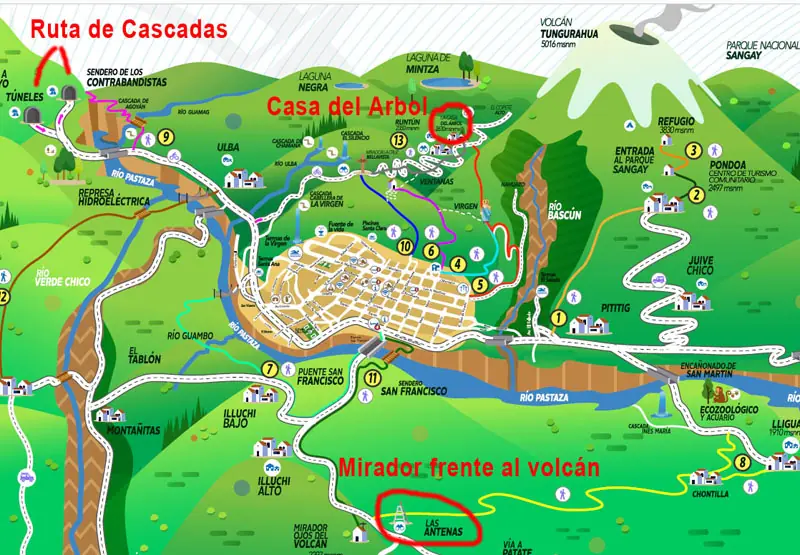
Visit the famous Tree House
You've probably seen those viral photos of someone swinging off the edge of a cliff, with a dreamy landscape in the background.
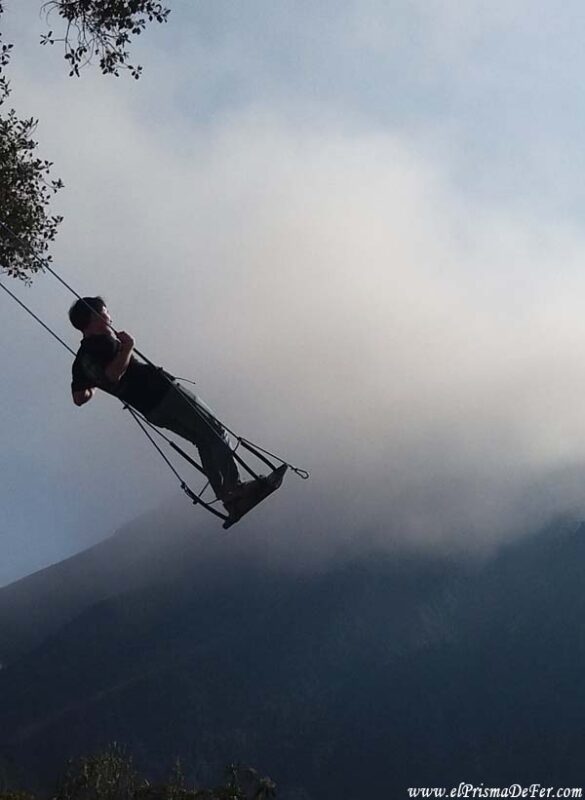
Whenever I saw them, I wondered what it would be like to be there, "flying" with the volcano behind me. That place exists, and it's not a fake: it's the famous Tree House in Baños de Agua Santa.
The Tree House is a simple wooden cabin built at 2,660 meters above sea level, right on the slope of the Tungurahua Volcano.

From there you can enjoy a privileged view and ride the iconic Swing at the End of the World, one of Ecuador's most recognizable symbols.
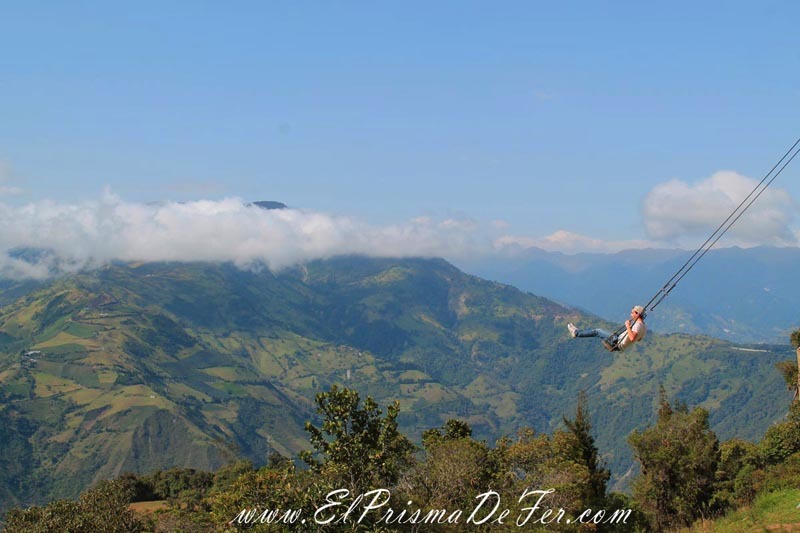
When I arrived, I discovered that, luckily, there isn't a real cliff below the swing, but rather a sloping terrain. But the ropes are so long and the height is so high that the sensation of flying over the void is completely real.
I had to wait quite a while to get a chance to swing, and the experience only lasted a minute. If you want to do it again, you'll have to wait in line again. It's a good feeling, although honestly, it seemed more like a "photo op" than an experience in itself.
In addition to the main swing, the area has other games and hammocks, and the surroundings invite you to linger for a while, enjoying the scenery. The best part, without a doubt, is the views of the volcano and the city of Baños, which make the trip worthwhile.
Admission costs 1 dollar, and the site is open daily from 07:00 to 19:00.
How to get to the Tree House
There are very inexpensive excursions that leave daily from Baños and go to the Tree House, with a cost that ranges between $6 and $10 dollars.
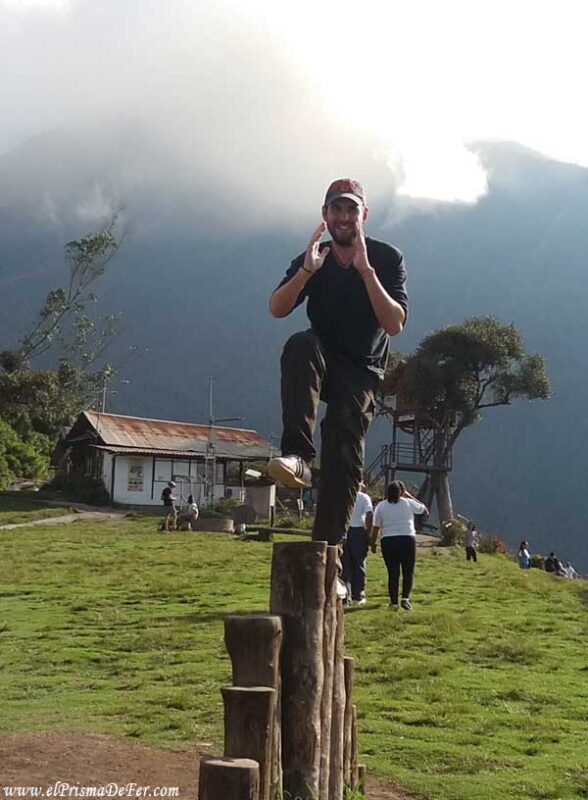
Si en cambio quieren ir en transporte público, existen buses que salen de la ciudad con destino a la Casa. Los horarios son 05:45, 8:00, 11:00, 14:00, 16:00, aunque conviene preguntar por las dudas hayan cambiado.
To return, you can wait for the same buses that go up to get off, or if you have energy, you can walk down.
It's a good stretch to walk, but you might get lucky and someone in their car or truck can take you to the city.
Observe the Tungurahua Volcano from different viewpoints
The town of Baños de Agua Santa is literally located at the foot of the Tungurahua Volcano, making it a place with impressive views from almost any point.
Already when I was traveling from the city of Ambato to Baños, kilometers away, I could see this colossal beast rising above the terrain.

The Tungurahua Volcano (also called “Mama Tungurahua”) is part of the Sangay National Park and is one of the most striking volcanoes in Ecuador. It stands 5,016 meters high, has a diameter of 14 km, and a crater 183 meters wide.
If you want to enjoy truly spectacular views, you can head to one of the nearby viewpoints. I visited two of them, which I'll tell you about below, although there are several more that are also worth a visit.
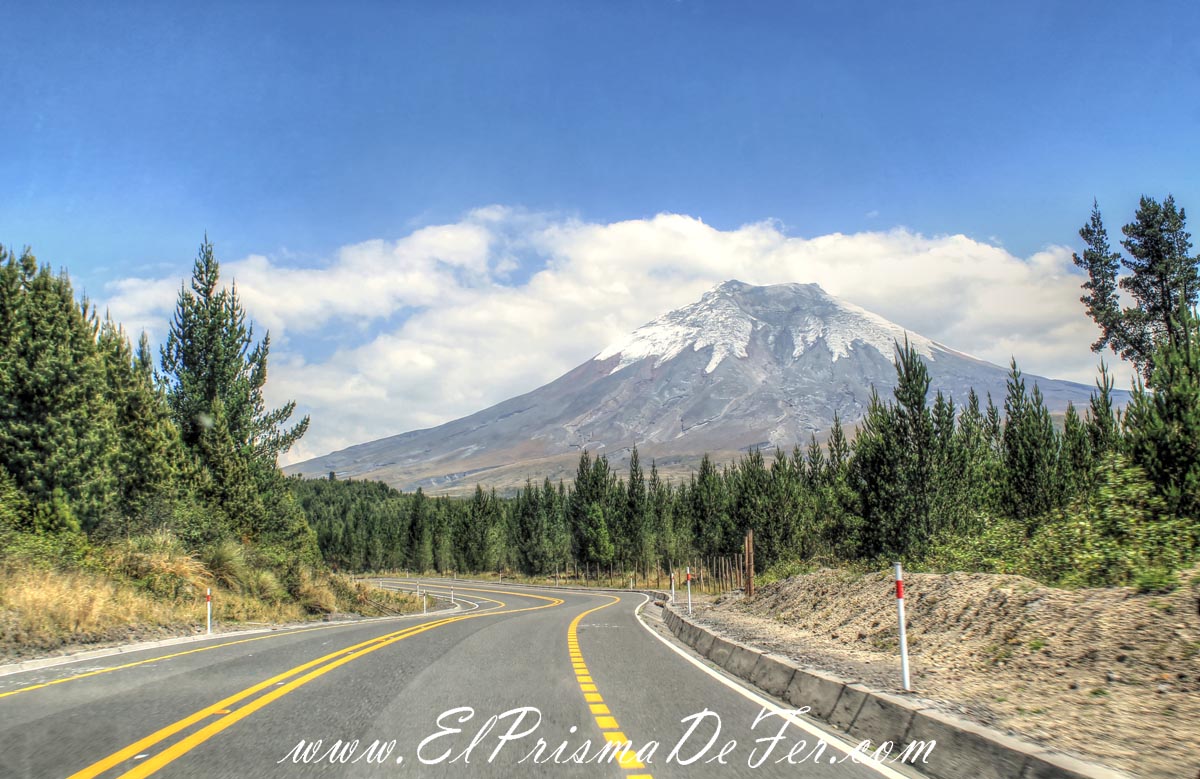
You may be interested in reading about how to visit the Cotopaxi Volcano.
Runtun Viewpoint
One of them is the Runtun Viewpoint, which is located on the grounds of the Casa del Arbol. From there, you can get firsthand views of Tungurahua, as we are right on the slopes of the volcano.
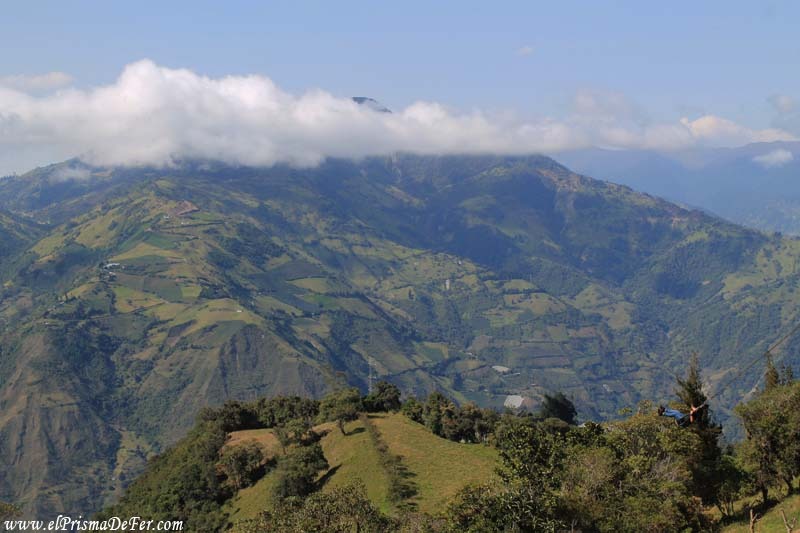
Antenna Viewpoint
The other viewpoint I recommend visiting is the one located right in front of the volcano, where you can see an antenna at the top.
The path to the antenna begins by crossing the bridge near the bus terminal, heading away from the volcano. Unfortunately, there's no public transportation to the summit, and it's not an easy journey on your own.
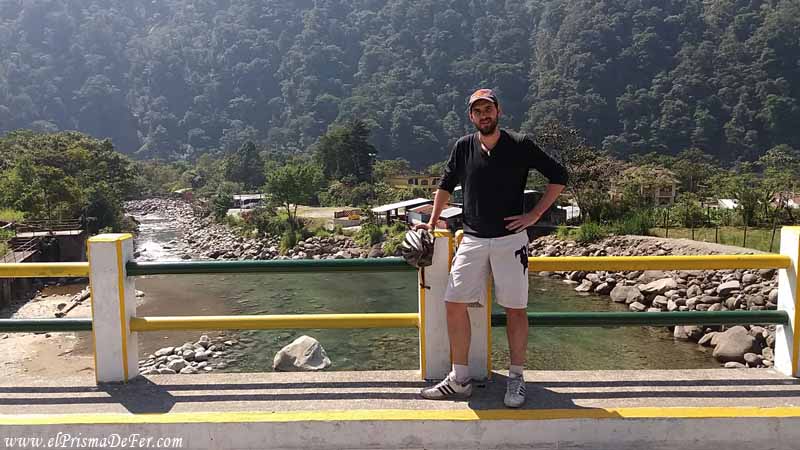
Without knowing exactly how far it was—it's about 8 km from the bridge—I started walking uphill. It's a paved road that zigzags up quite steeply.
After a while of climbing, I was already feeling exhausted, even though there was still a long way to go. But luckily, before I could resign myself to turning back, a minivan with a group of Dutch tourists passed by and invited me to hop on.

Reaching the Top
I was very grateful to them throughout the trip, especially when we reached the summit. Coming down, you feel the chill of the altitude, but any discomfort disappears when you take in the incredible views ahead.
In front of us rises Tungurahua, and in my opinion it is the best viewpoint I found in all of Baños, even better than the Tree House.
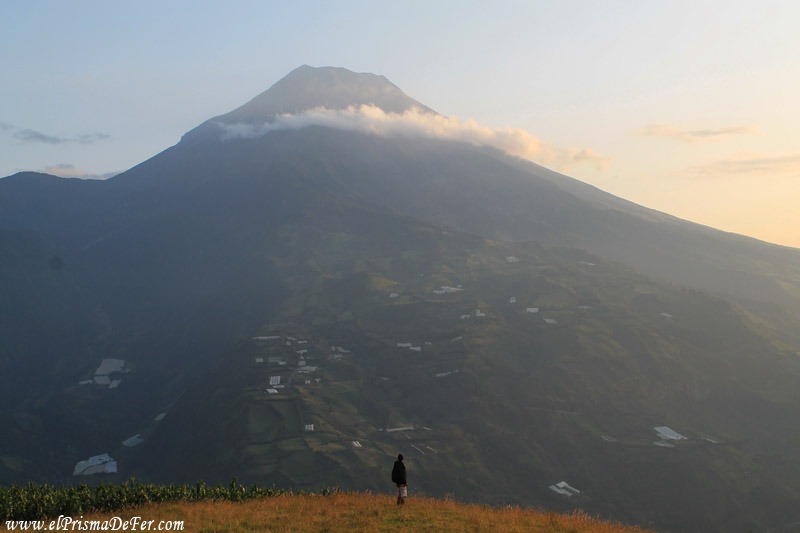
There's no one around: just the countryside, the antenna, and a few passing clouds, creating a unique landscape that's hard to forget.
After a good time taking photos and admiring the volcano, we returned to the city. I tried to offer the guide something as a token of gratitude, but he flatly refused. His help was completely selfless, and I remain very grateful for it to this day.
Route of the Waterfalls
One of Baños' most popular activities is the Waterfall Route, a route that connects more than a dozen impressive waterfalls over several kilometers.
Durante la ruta se pueden encontrar cascadas de diferentes tamaños, pero la más conocida es el Devil's Pail, un salto poderoso y ancho que impresiona por la fuerza del agua y el entorno rocoso. Hay pasarelas y puentes que permiten acercarse lo suficiente para sentir la fuerza del agua y tomar fotos únicas.
Along the way, there are also viewpoints and small villages where you can rest or try local food.
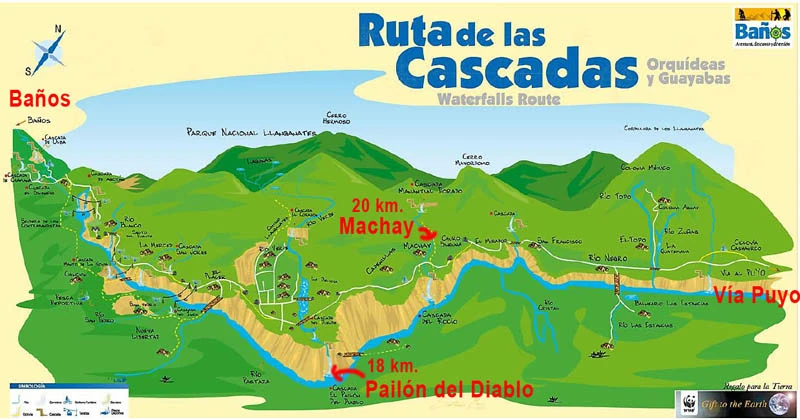
Main waterfalls on the Route
Agoyán
A waterfall that can be seen from viewpoints over the Pastaza River, it's often combined with nearby activities like ziplining. It's not one of the largest, but its surroundings are attractive.
Distance: Very close to Baños (~7 km from Baños)
Bride's Veil (Manto de la Novia)
It stands out for its white drapery, reminiscent of a bridal veil ("mantle"). There's a suspension bridge and a cable car or trail leading to the viewing point, offering panoramic views that are ideal for photos.
Distance: Approximately 10-15 km from Baños along the same Waterfalls Route.
Devil’s Cauldron (Pailón del Diablo)
It's the most impressive. It's about 80 meters high, with several walkways and suspension bridges, views from above and below, and jungle trails. In many sections, you'll get wet from the spray.

Distance: ~17-18 km via Baños-Puyo (about 20-30 min by car or bus)
Machay Waterfall (El Rocío Machay)
A series of waterfalls (between 10 and 40 meters high), natural pools of crystal-clear water, and lush vegetation, ideal for light walks and swimming in hot weather. An ecological trail, viewpoints, and tranquility await you.
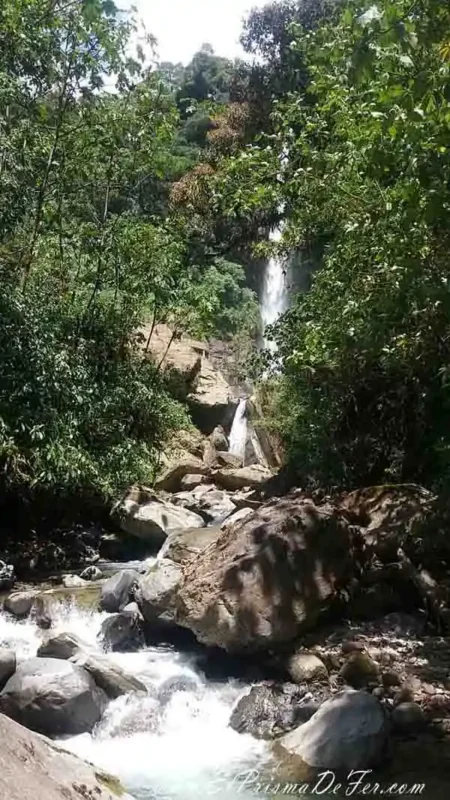
Distance: ~20 km from Baños to Río Verde; access via the Waterfalls Route.
How to visit the Baños Waterfalls Route
The Waterfalls Route can be hiked or explored independently, on foot or by bike, and offers several transportation options that allow you to shorten sections if you don't want to do the entire route on foot.
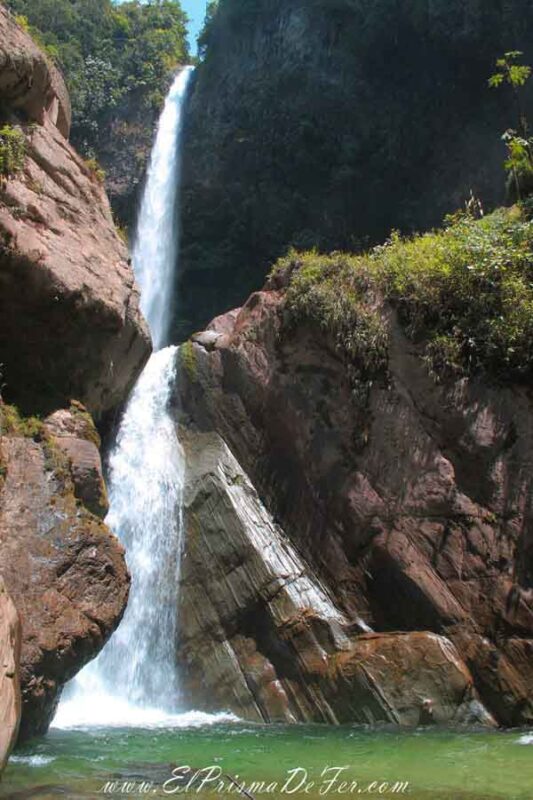
What is the waterfalls tour like in Baños?
I booked the tour offered by the Chivay (those open-top tourist buses) from the main square. The entire excursion was supposed to last three hours and I would visit the Pailon del Diablo waterfall (the most impressive) and the Machay waterfalls.
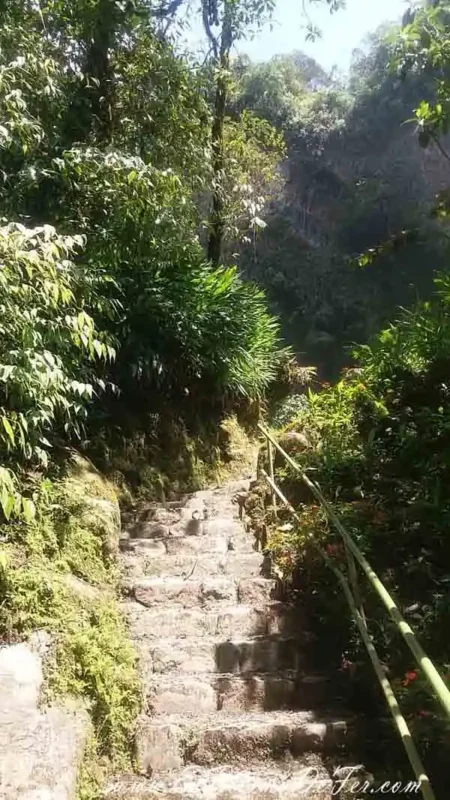
But the reality is that wasn't the case. It starts off well with the guide describing the natural surroundings. He makes a quick stop to see a small waterfall along the route and tells us other facts about the falls and other attractions.
But what ended up being a disappointment for me was that one of the stops was for zip-lining over the Pastaza River. Sounds good on paper, but it turns out the group had to wait nearly 40 minutes until everyone who wanted to could do the activity.

This meant we lost valuable time to visit the most important waterfalls along the route, which, after all, was why I had booked this excursion.
When we finally arrived at the Devil's Pailon, the guide told us that since we were running late, we only had a few minutes to explore the waterfall on the upper side. Meaning, I had to rush through them and return a little later.
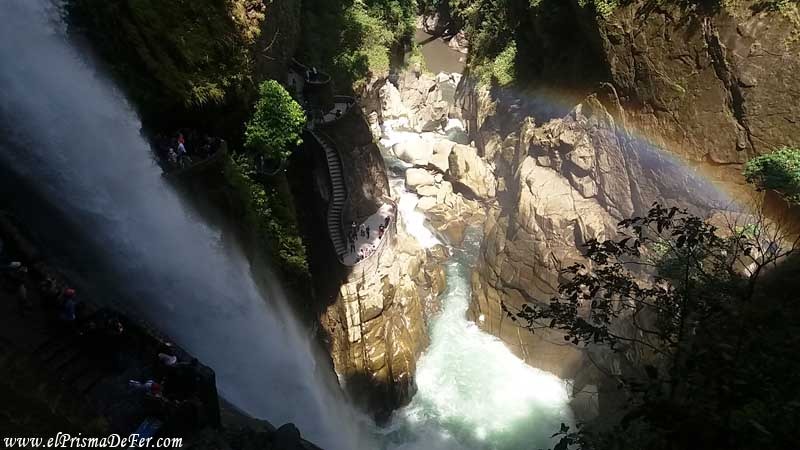
To top it all off, since we didn't have any more time, we didn't even get to see the waterfalls further along the route... in short, rubbish.
My conclusion is that this tour can be worth it if you're short on time or don't want to complicate things with your own transportation, but I personally don't recommend it if you want to truly enjoy the Waterfalls Route.
Bike the Waterfalls Route (best option)
Since I wanted to do the tour my way, the next day I rented a bike that I could use as long as I wanted for $5.
The outward journey is generally flat and hilly, so it doesn't require much effort. The route is safe, as cars, being accustomed to it, aren't a problem. Furthermore, they can't go very fast due to the constant curves.
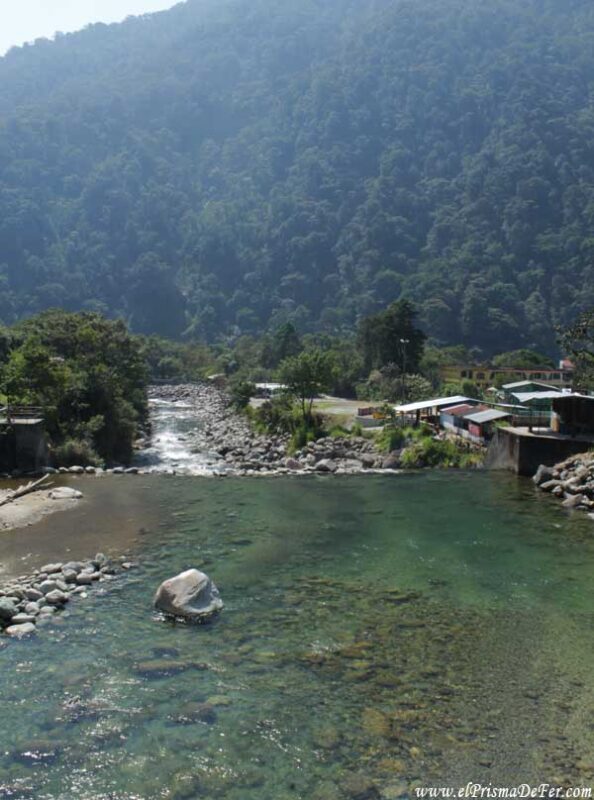
The good thing about going by bike, or on foot, is that if you're too tired to pedal or walk back, in the towns we pass through, or even along the route, there are buses that will take you back to the city for $2, and you avoid the climbs on the way back.
Esta vez, con más tiempo, pude recorrer el Devil's Pail con calma. Caminé por el sendero del mirador superior, disfrutando del sonido ensordecedor del agua y las vistas espectaculares del salto sin prisas.
I then went down to the lower part of the waterfall, the section with steps that you can see from above and that allows you to feel the full force of the water just a few meters away. To access this area, you have to enter through another entrance, but it's completely worth it.
I also had time to visit the Machay Waterfalls. They're not as impressive as the previous one, but they have the unique feature of being able to get up close and personal with the waterfall. It's very nice. The path to get there is also very pretty, with vegetation and not too crowded.
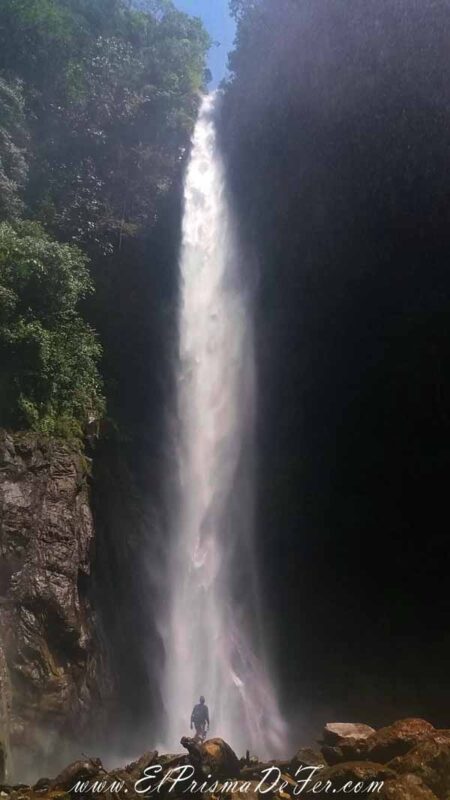
On an excursion from Quito
Si estás en Quito y querés visitar las cascadas de Baños sin preocuparte por la organización, hay varias agencias que ofrecen day trips. Estos tours suelen incluir el traslado ida y vuelta, paradas panorámicas en el camino y la visita a las principales cascadas, entre ellas el Devil's Pail.
It's a good option if you're short on time or prefer a more comfortable trip, although it's always best to stay at least one night in Baños to calmly enjoy all its attractions.
Hello Life Ecological Reserve
About 30 km from Baños, following the Ruta de las Cascadas, is the Hola Vida Ecological Reserve, an ideal place for those looking for a more natural and less crowded experience.
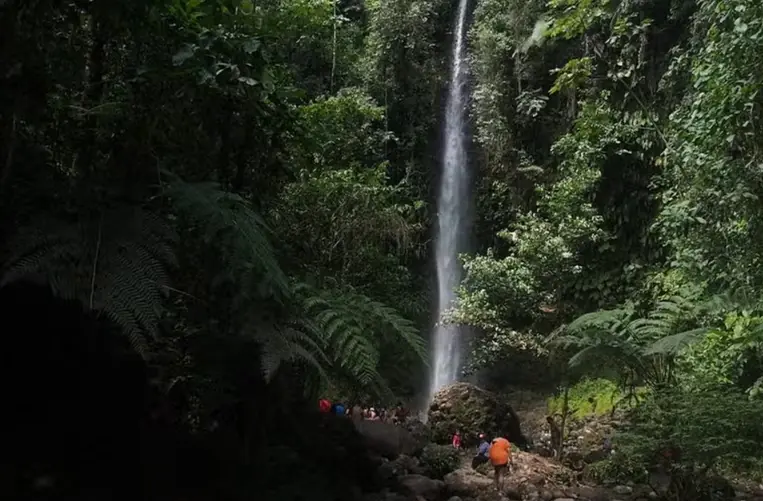
This tropical rainforest sanctuary belongs to the Ecuadorian Amazon region and perfectly combines hiking along jungle trails, swimming in crystal-clear waterfalls, and observing the local flora and fauna.
The main route within the reserve takes around 1.5 hours, passing by different panoramic points until reaching the Hola Vida Waterfall, where it is possible to bathe in its waters.
From Baños you can get there on your own by car or by booking organized tours that include transportation, a local guide, and free time to enjoy the surroundings.
Extreme Sports
The city of Baños de Agua Santa is known as the capital of adventureHere you have the opportunity to do all kinds of adventure sports such as canopy, canyoning, climbing, trekking, cycling, paragliding, rafting, horseback riding, among others.
Canopy ziplining is one of the most popular activities, as it involves crossing from one bank to the other from a considerable height via a cable. You can also see a lot of jumping into the void or rafting on the Pastaza River.

Natural Hot Springs
Another of the benefits we can find in Baños are its natural hot springs, ideal for relaxing after a day of activity.
La ciudad cuenta con cuatro complejos termales, que hacen uso de aguas subterráneas calentadas gracias al volcán Tungurahua y aguas que vienen desde las montañas que rodean la ciudad, las cuales tienen propiedades curativas.
The closest hot springs, just a few blocks from the main square, are the Virgen hot springs. There are eight pools with different temperatures. The cost is $6 for adults and $3 for children. They are open Wednesday through Friday from 2:00 PM to 8:30 PM, and Saturdays, Sundays, and holidays from 10:00 AM to 8:30 PM.
Another complex are the Hot Springs of El SaladoHere you'll find pools of yellowish hot springs, colored by their mineral properties, which relieve pain. Located on El Salado Avenue, the spa costs $$3 for adults and $$1 for children.
The other two complexes are the Santa Ana Hot Springs and the Santa Clara Spa.
Climb to the top of the Tungurahua Volcano
I didn't do it, but according to the official Baños Tourism website, it's not difficult to reach the summit, from which you can see a permanent glacier at its peak.
It has a reactivation process every 80 years and is usually very visited to be able to observe how the smoke and ash emitted by Tungurahua forms figures and presents incandescent spectacles on the horizon.
At the moment ascents are being made but you must hire a specialized guide.
How to get to the Tungurahua Volcano
There are two access routes to enter the site. The first is located in the Pondóa sector, a community located 2,480 meters above sea level. From this point, and after approximately four hours of hiking with the help of a local guide, you can ascend the volcano, as long as it is not active.
The second access route begins from Puela on the Baños – Riobamba highway. You can access by car to the Palitahua sector where a trail begins that is divided into two sections: the first leads to the Palitahua hot springs that are located at the foot of the Tungurahua volcano and the second to the southwestern flanks of the volcano where we will find the Minsas lagoons.
Private tours in Baños de Agua Santa
The activities I recommend in this post contain affiliate links. This means that if you book through them, I'll receive a small commission at no extra cost to you. It's a way to support my work and help me keep this space alive, filled with stories and travel tips. Thanks for joining me along the way ;)!

Where to sleep in Baños de Agua Santa
Baños is a small city, so most accommodations are concentrated near the center, a few blocks from the main square. This is the most convenient area for getting around on foot, as tours depart from there, restaurants are located, and the bus terminal is located.
There are options for all budgets, from budget and backpacker hostels with shared rooms and a social atmosphere, to boutique hotels with views of the Tungurahua volcano and spa services or private hot springs.
Some travelers also prefer to stay a little further from the center, in the hills surrounding Baños, where eco-lodges and cabins with panoramic views of the valley abound.
I stayed at Hostels Great Backpackers. It has shared rooms, and I honestly can't complain. Great atmosphere, spacious common rooms, and a garden. I recommend it if you like the hostel vibe.
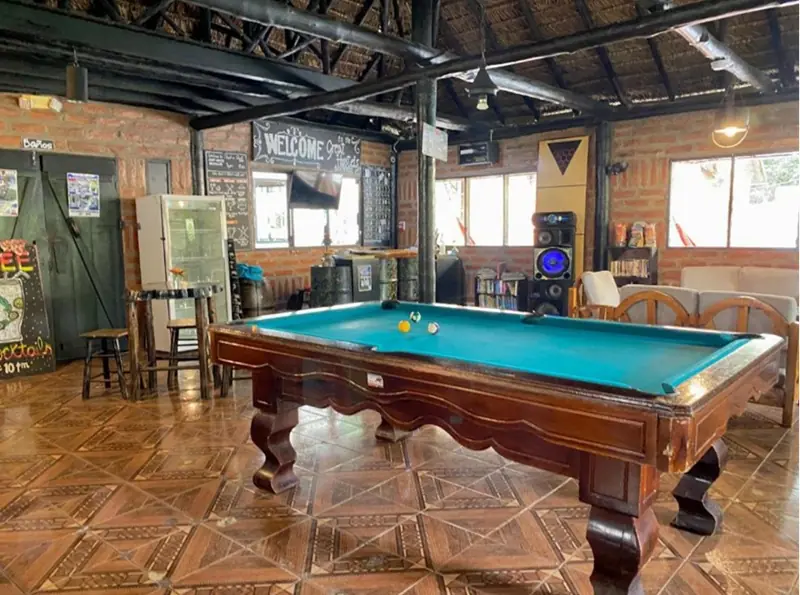
Best time to visit Baños de Agua Santa
Baños can be visited all year round, as its temperate and humid climate makes it an ideal destination in any season.
The dry season runs from June to September, with clearer days and less rain, making it easier to enjoy outdoor activities like trekking, visiting waterfalls, or taking the famous swing at the end of the world. It's the ideal time if you want to enjoy great views of the Tungurahua volcano.
On the other hand, from October to May is the rainy season, although in Baños it usually rains for short periods and then the sun comes out. This time has the advantage of the landscape being greener and the waterfalls being more abundant, which enhances the natural charm of the place.
Be careful not to trust the weather pages, as in the months of June and July, temperatures are reported as 0° to 5°, and this is because the nearest weather station is near a volcano.
Final thoughts
Baños de Agua Santa was, without a doubt, one of my favorite places in all of Ecuador.
I loved the unique combination of lush nature, stunning waterfalls, jungle, and the imposing Tungurahua volcano looming in the background. Although I'm not particularly fond of extreme sports, I thoroughly enjoyed every corner of the place.
Among what I liked the most, I highlight the Pailón del Diablo, the Machay waterfalls and the views of the volcano, which are simply spectacular. On the downside, I'd only mention the chivas tour, which left me with a somewhat bitter taste in my mouth. Other than that, the rest of the activities and tours were absolutely fantastic.
After three incredible days in Baños, it was time to continue on to my next destination: Latacunga. Very different from Baños in terms of atmosphere, but an excellent starting point to visit two natural gems of Ecuador: La Laguna de Quilotoa and Cotopaxi National Park.
Support The Prism of Fer!
Your support helps me continue creating free content on the blog. Thank you so much!



